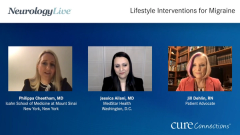
Lifestyle Interventions for Migraine
Recommendations for incorporating and adhering to lifestyle interventions that can help prevent migraine or reduce the severity of attacks.
Episodes in this series

Philippa Cheetham, MD: There is another point I wanted to bring up: To me, there are many similarities in the triggers with patients who suffer from the viral activation of herpes simplex, the cold sore virus. We used to be taught at medical school that the triggers are excessive sunlight, stress, menstrual cycle changes, dietary issues, and flying. Then we hear about all these lifestyle triggers. It’s a busy world where we are on the go. We all know the right things to do, but as a busy surgeon being told to pay attention to eating 3 meals a day, getting 8 hours of sleep, avoiding flying, avoiding dehydration—it is overwhelming. That advice is great when you are in a 9-hour operation, when you are stressed or dehydrated, when you’re under the bright operating lights, when you may be flying off later that night to present at conference. That is 1 of the most frustrating things; I know the good medicine, the good lifestyle factors to address. But on so many days of my life, it is just not possible to get 8 hours of sleep, to avoid the bright lights of the operating room and to eat 3 meals a day. Sometimes, when I have a really bad migraine, I think to myself, “You know what—I should invest in a personal chef who travels with me 24-7 because it would be worth the money to avoid the hell of the migraine, just to eat healthfully and to be hydrated.” Jill, how do you balance these lifestyle issues, like routine meals, sleep hygiene, and regular exercise, while managing these migraine triggers in reality?
Jill Dehlin, RN: It is not easy. If my migraine attack is not quite so bad, and I am well enough to bend over and tie my shoes to go for a walk with my dog, I find that that really does help decrease the pain. But as Dr Ailani said, there are days that patients with migraine just cannot even get out of bed or even think about going to the mailbox and putting a bill in the mail. It is just too much for people to wrap their head around. Many people, aside from the horrible pain, experience such horrible fatigue—overwhelming fatigue—and they really cannot even move.
Philippa Cheetham, MD: Do you find as well, Dr Ailani, that now that people have such busy lives, they do not want to accept that? They may say, “Why should I change my lifestyle when you can give me a pill to take this away so that I can carry on this crazy 15-hour workday where I am flying here, flying there, and being on the move?” I think about so many moms when they get a migraine, and they have 3 little children at home. It is not easy to crawl into the cave of their bedroom for 6 hours under a duvet and come out the following day.
Jessica Ailani, MD: It is very accurate to say that people find that taking medication is easier, until they take the medicine, have adverse effects, and then want to come off the medicine. I do not think it takes much time for patients to realize that there is this balance that needs to be achieved. The 1 thing I have learned in clinical practice is when to introduce lifestyle discussion. Sometimes we do it right away in the first visit, but sometimes we cannot, not when we are approaching a situation where a patient with migraine is clearly overwhelmed by their lifestyle. We might realize that this is probably triggering some portion of the attack, but it is not the entirety of the picture. Even if you address all these lifestyle factors, most patients will continue to have migraine attacks. They might be less frequent, but they’re not going away.
Sometimes it is best to get them started on a treatment path. Then I advise my patients, “We’re starting you on prevention.” Sometimes the goal is to get patients to a better place. Sometimes prevention will continue forever depending on how it was before we started it. Sometimes we can ease patients with migraine off medication. The only way we can do that is when lifestyle issues have completely been addressed and I feel that my patients are exercising regularly, they have a sleep schedule, that they are doing good for themselves. Every visit starts to become a little conversation about how much patients with migraine can do, which is just like what Jill said: Sometimes it is just not possible, and for some patients it is almost never possible.
We start to pin very small goals. Did you tie your shoe today? That would be my goal for Jill. Did the dog go outside and did you sit outdoors? Many times, especially right now because it is cold, I’ve had a lot of discussions with patients with migraine just about the importance of going outdoors. If they cannot walk, they can just take a chair and sit down or stand and see some sunlight for 5 to 10 minutes. That is extremely important for the brain. It is extremely important for our health, and we are getting so isolated being indoors so much. Medical professionals should take it per patient and try to make those lifestyle bits smaller and more manageable if patients with migraine are overwhelmed, but we cannot tell people not to fly, travel, stress, or work because then they are not going to come back.
Philippa Cheetham, MD: A large percentage of patients have already seen a pattern in their own migraine triggers, and it may not come as such a surprise to them if they have these obvious triggers. Sometimes, however, patients with migraines just need that reinforcement, that it is not just about them as an individual, that these are well-documented triggers for patients with migraines, and that they’re not alone. I have been very particular about trying to reduce fluorescent lighting. In 1 of my offices I banned the fluorescent lights completely and have lamps on the table. Patients have come in and noted how calming it is to come into this environment. Other patients look at me a little strange, almost as if to say, “Why is it 10 o’clock in the morning and you are in a room with this very romantic lighting while you’re telling me about my prostate cancer?” Some people just want a lot of bright, glaring light.
It’s amazing, actually: If you recognize those triggers, you can certainly bring those into your workplace. I have to say, over the years, I have certainly had a few raised eyebrows when I have adjusted the lighting. People think I am a little crazy when I say on a Thursday, “I know I’m going to get a migraine on a Thursday because I have a particular office that has fluorescent lighting all the way down the corridor.” You can certainly see that look people give, like, “Whatever you think.” It’s hard to convince people sometimes that this is really a trigger and not just in my mind.
Jill Dehlin, RN: I was thinking about how I taught a roomful of fifth-grade boys with a migraine attack; I taught sex education. When you have a room filled with about 40 boys, and you’re dealing with a migraine attack, what do you do? I just asked the students, “How many of you have ever had a headache?” Almost every hand went up. When I asked how many of them had ever heard of migraines, a lot of hands went up. When I asked them if they had ever had a migraine attack, a surprising number of hands went up. I used my attack as a teachable moment, as I often do in other social situations. I told them that I was having a migraine attack, and that that was what it was looking like for me that day. The lights were bothering me, so I turned down the lights—we had a little mood lighting like you did in your office—and I asked them to please be as quiet as possible. They were so good, except when I got talking about my curriculum and a young man nervously was squishing his plastic water bottle. It was an excruciating sound for me. It is so strange, those sensations.
Philippa Cheetham, MD: Thank you for watching Neurology Live® Cure Connections®. If you enjoyed the program, please subscribe to our e-newsletter to receive upcoming programs and other great content right in your in-box. Thank you so much.
Transcript Edited for Clarity
Newsletter
Keep your finger on the pulse of neurology—subscribe to NeurologyLive for expert interviews, new data, and breakthrough treatment updates.



















































